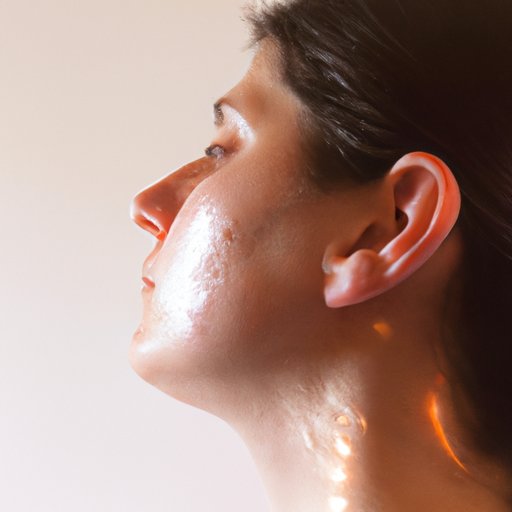
I. Introduction
Sunspots, or solar lentigines, are dark patches of skin that appear on areas of the body that have been frequently exposed to the sun. They are usually harmless, but can be a cosmetic concern for many people. Sunspots are a common problem for people of all ages and skin types, but they are more common in people with fair skin and those who spend a lot of time in the sun without protection.
II. Prevention
The best way to get rid of sunspots is to prevent them from forming in the first place. The most important thing you can do to prevent sunspots is to wear sunblock every day, even on cloudy days. Sunblock should be applied 30 minutes before going outside and reapplied every two hours. Look for a sunscreen with an SPF of at least 30 and that offers broad-spectrum protection against UVA and UVB rays.
There are two types of sunblocks: physical and chemical. Physical sunblocks, such as zinc oxide and titanium dioxide, work by reflecting the sun’s rays. Chemical sunblocks, such as avobenzone and oxybenzone, absorb the sun’s rays and convert them into heat. Both types are effective, but physical sunblocks are less likely to irritate the skin.
When applying sunblock, make sure to use enough to cover all exposed skin. Most people don’t use enough, which means they aren’t getting the full SPF protection. A good rule of thumb is to use a shot glass-sized amount of sunscreen for the entire body.
III. Natural Remedies
If you already have sunspots, there are several natural remedies that may help fade them over time. Lemon juice is a natural bleaching agent that can help lighten dark spots. Apply fresh lemon juice to the affected area and leave it on for 10-15 minutes before rinsing off. Be sure to use sunscreen after applying lemon juice, as it can make your skin more sensitive to the sun.
Aloe vera is another natural remedy that can soothe and moisturize the skin while also helping to fade sunspots. Apply fresh aloe vera gel to the affected area and leave it on for 15-20 minutes before rinsing off.
Honey mixed with yogurt is another natural remedy that can help brighten the skin and fade dark spots. Mix equal parts honey and plain yogurt and apply to the affected area. Leave it on for 20-30 minutes before rinsing off.
IV. Over-the-counter Solutions
If natural remedies don’t work, there are several over-the-counter solutions that may help fade sunspots. Hydroquinone is a skin lightener that works by inhibiting the production of melanin, the pigment that gives skin its color. Retinol is a form of vitamin A that helps to exfoliate and brighten the skin. Vitamin C is a powerful antioxidant that can help protect the skin from damage caused by the sun.
V. Medical Treatments
If over-the-counter solutions don’t work, there are several medical treatments that may help fade sunspots. Chemical peels involve applying a chemical solution to the skin to remove the outer layer of dead skin cells, revealing brighter, more even-toned skin underneath. Cryotherapy involves freezing the sunspot with liquid nitrogen, which causes it to peel off over time. Laser therapy uses intense pulsed light to destroy the pigmented cells in the skin, causing them to fade over time.
VI. Early Detection and Regular Skin Checkups
The most important thing you can do to prevent sunspots from developing into skin cancer is to get regular skin checkups with a dermatologist. A dermatologist can identify early signs of skin cancer and recommend treatment if necessary. It’s also important to perform regular self-examinations at home to look for any changes in the skin.
If you notice any changes in your skin, such as a new growth, a mole that has changed, or a sore that won’t heal, make an appointment with your dermatologist right away.
VII. Additional Tips for Preventing Sunspots
In addition to wearing sunblock and getting regular skin checkups, there are several other things you can do to prevent sunspots. Avoid peak sun hours, which are between 10 a.m. and 4 p.m., when the sun’s rays are the strongest. Wear protective clothing, such as a wide-brimmed hat, long-sleeved shirt, and sunglasses, to protect your skin from the sun. Making dietary changes, such as eating a diet rich in antioxidants, may also help protect your skin from sun damage.
VIII. Conclusion
Sunspots are a common problem for people of all ages and skin types, but there are several ways to prevent and get rid of them. By wearing sunblock every day, using natural remedies and over-the-counter solutions, getting regular skin checkups, and taking other preventive measures, you can protect your skin from sun damage and maintain a bright, even complexion.
Remember to take care of your skin and stay protected from the sun to avoid developing sunspots. By following these tips, you can help keep your skin looking healthy and radiant for years to come.




